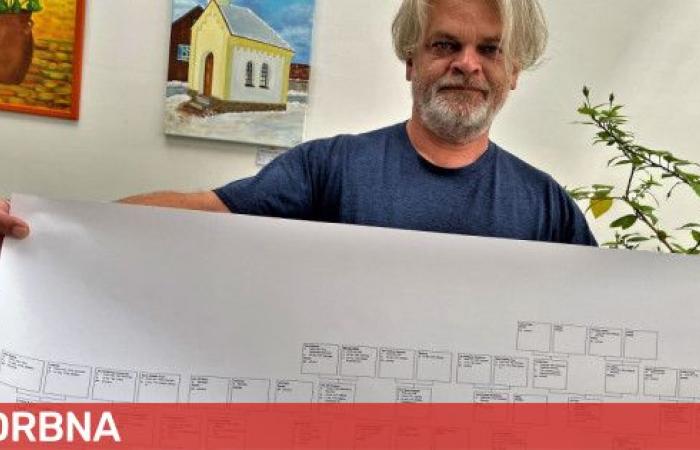
Ivan Kuba Jakubík from southern Pilsen has been searching for ancient ancestors and creating family trees for almost ten years. In addition to those from the Czech Republic, his clients also include people with Czech roots living in the USA, France, Germany, Russia, Central America and other countries. Thanks to his family tree, he himself discovered that he was a relative of the last Pilsen executioner, Matěj Kaiser.
Ivan Kuba Jakubík got to his family trees by a detour when, after ten years of commuting to Prague, he quit working in television and started working on a construction site to clear his head. “In less than a year, I flew through the ceiling at work, broke a few vertebrae and wondered what to do next. I was contacted by a friend who had her family tree done and complained that it took a long time. She told me I might as well try it. I studied museology in Brno, which includes genealogy as one of the so-called auxiliary sciences of history, so I got into it. Of course, I first made my own family tree, or more precisely, an extract from my ancestors. And then it went quickly. I started websites, to refresh my knowledge I took a course of the Czech Genealogical and Heraldic Society in Prague, of which I am also a member, and that’s how it all started.”
One of the first customers was an American woman who later came to visit the Czech Republic with her family. “I accompanied them here. I also found specific places where their ancestors lived, we went around it all together and it was very pleasant. They could touch the houses where their ancestors lived in the middle of the 19th century. The lady was from New York, and she was a very high-ranking person.” Kuba remembers the very beginnings in a new field. According to him, Americans very often search for their roots. There are a lot of Mormons out there whose faith places a lot of emphasis on family history. That’s why they go to Europe and have their family trees processed here.
The ancestors of foreigners from many countries, whose family trees Cuba prepared, mostly left our territory in the 19th century. “Another of my American clients, who owns extensive vineyards in California and produces his own wine, was also interesting. For him, in addition to the classic family tree, I also found the land that his ancestors owned here. His family lived in one place for almost 400 years. He laughed a lot because he always thought how big his land in America was. But when he saw what his ancestors had here, he said he felt like a total fool.”
Another client from the USA also turned to the Czech expert through family trees, and it turned out that he is an African American. But his mother came from the Sudetenland, from Ústí nad Labem. After being deported to Germany, she found an American soldier who was black. They had a child, they all went to the USA together. There, however, the mother immediately disappeared from the family. “The boy didn’t know her all his life. His mother only spoke to him when she was on her deathbed in the hospital and told him where she was from. He began to search for it and wanted to know if it had any relatives anywhere. It was an extremely interesting search, because the Sudeten Germans have their own genealogical pages. I found when his mother’s mother died in Germany. I found out where she is buried in Germany and contacted the relevant cemetery. I found out who was paying for the grave and put that person in touch with my client in the US.”
Where does the whole complex search actually begin?
Today, fortunately, almost everything can be found on the Internet, there is no need to travel to the terrain in any complicated way. “But we have to follow the law on registries and archives. If we take, for example, the birth register, entries are made in it one after the other. When this book is fully described and 100 years have passed since the last entry, it is transferred to the archive. Books are digitized there. This means that one page at a time is photographed and stored electronically. According to current legislation, death data can be published after 30 years, marriage data after 75 years,” Cuba explains.
“Now that I’m researching, the published birth data is usually around 1910 and older. When people in the family have documents from that time, I can go straight to the internet and start searching. If they don’t have it, which is most of the cases, then I have to take, for example, their grandfather and grandmother. I know their names and places of birth, I will find the village or town and the relevant registry office. I get written power of attorney from clients authorizing me to search for their ancestors and make requests for information. The applicant must also give me his birth certificate, which also lists his grandfather. Everything has to be verified and it has to be direct ancestors,” describes the beginning of the genealogy creator’s research.
The ant’s research work itself begins by writing to the registry offices to get the necessary documents for him, and he has to write until he gets to the first person’s data, which is already publicly available on the web. “After that, it’s time to leave the Internet. I travel only in the Pilsen Region. Sometimes it’s faster to go there and find it in a book than to wait for a letter from the office. It also depends on specific registrars. Sometimes when I apply, I get it in three days, sometimes in a month. But usually there is a very good agreement with them, I would like to praise them for their cooperation and willingness.”
What do genealogy researchers need to master?
Anyone who wants to seriously start creating a family tree should have at least some basic knowledge of German and Latin, it is also important to be able to read Schwabach. “However, some Czech pastors wrote in such a way that it is even more difficult to read than the German schwabach. You just have to get used to it over time. They must also learn how the registers are organized, how parishes were divided in districts and regions. The distribution of parishes at that time does not correspond to today’s territorial division.”
Kuba charges its clients a rate for one record found, which is a birth, the next record is a marriage, the next record is a death. “There is a fixed amount. I usually agree with people that I will do the work for them for, say, 20,000. When I collect this data and show them the result, we will agree if that is enough for them or if I should continue in depth. When I have the documents, I don’t have to write on the registers and I go straight to the Internet, a less extensive family tree can be mastered even in 14 days of relatively hard work. But now I’ve been working on one family tree since April and I’ll probably spend a few more months on it. It is very comprehensive. I was assigned to search as long as I could, wherever I could get to.’
You can usually get to the turn of the 17th and 18th centuries during research. But that is far from being the rule. “I may as well end up as early as the 19th century when the records are missing. Some may be destroyed, but this is also often due to errors and inaccuracies that individual parish priests wrote in the registers.
Ivan Kuba Jakubík got the furthest in his research until about 1650. “There you can already use the “Berni ruli”. In the White Mountain era, inventories were made of how many people lived in the country and what kind of property they farmed. It was done for taxes, of course. At that time, officials toured the entire territory and listed residents and property. In the collection roll, for example, it is possible to find information that the farmer Franta Vomáčka lives in the village of Přešín and farms on four farms, he has five cows, thirty sheep, eight goats and two carts, and that he is exempt from paying taxes for a certain period of time because his farm burned down . These are very interesting data. In the 18th and 19th centuries, entries about soldiers often appear in the registers, there I often find out where the soldier served, in which unit, to whom individual regiments belonged. Sometimes, of course, I can also search for those plots, as in the case of an American client. Old cadastral maps are used for this, for example.”
Everyone wants to find a noble in the family tree
Of course, everyone wants to discover some noble ancestors in their family trees. “In the ten years that I have been engaged in this activity, I have come across one nobleman. It was a family of lords Vidlák from Radslavice. By the way, “redneck” was not originally a derogatory term. It came about because the lords were very poor nobility. Often they didn’t even have a sword, it was terribly expensive back then, it was like having a car. But their duty was to defend their master, under whom they fell. So when they went into battle, instead of a sword, they often went with pitchforks. And that’s how the term “redneck” came into being. It doesn’t mean, as it does today, that he’s a buran from the village.”
“I have another incident. The lady turned to me and said that their grandmother’s name was Půtová. She is said to have made up her mind that she must necessarily be related to Půta Švihovský from Rýzmberk. I tried to mislead her, because Půta was of course a first name and not a surname. But grandma was so stubborn that I had to make a family tree with him to convince her that they really don’t have any nobility there.” Cuba recalls.
And there is no shortage of other interesting things from ancient history either. “Also, I have occasionally encountered that he was a farmer, then passed the farm on to his son, retired, and when he died, his occupation or social status was listed as ‘beggar.'” This shocked some clients. But it was not a beggar in today’s sense of the word. They still lived on that farm, but there were, for example, some bad relationships, they also came to the farm and had nothing. So they were labeled as beggars, even though they still lived with the family and did not starve to death.”
Kuba comes from the Katow family
Modern technology has also significantly affected the creation of family trees, but if someone thinks that they can download a program to their computer and then find their ancestors in the database, they are seriously mistaken. The programs are mainly used for editing. “There are various genealogy programs, I personally use MyHeritage and Family Tree Builder. Searched data and links are then entered there. I don’t just give people information that, for example, on March 1, 1860, our favorite Franta Vomáčka was born in Dolní Lhota. In addition to the information on paper, I will also give them an internet link directly to the registry where they can check it. They can then upload the data to the free application they downloaded and click on the links in it. They will also receive a special booklet with all the clickable links as well.”
“During research, various strange records are found. For example, in the birth register, the mother is listed as a fallen person Růžena Černá, and instead of the father’s name, it is written “Who knows where.” That’s how the priest wrote it there. The causes of death are often described in an interesting way, but it tends to be unpleasant reading. In my family tree, I found out that my grandfather was the first in the family who left Šumava. All of them had lived in solitude there before, because it was mostly comfortable. Perhaps it is also related to the fact that I feel very well in Šumava, in the solitude, and I don’t look for new acquaintances very much. I got quite deep in my family tree and found out through German registries that I come from Bavarian Katowice families. The last Pilsen executioner, who died in 1831, was the brother of my direct ancestor, his name was Matěj Kaiser.” adds Ivan Kuba Jakubík at the end of our conversation.
Tags: Creating family trees searching ancient ancestors fun living relative Pilsen executioner Company News
-




